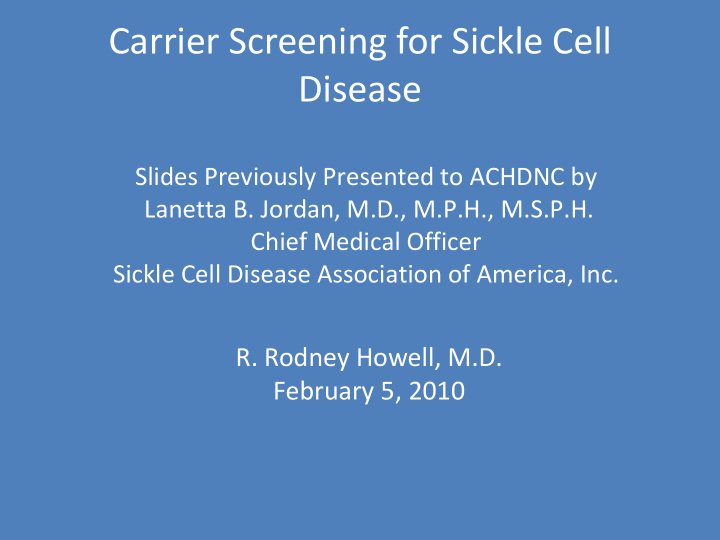



Carrier Screening for Sickle Cell Disease Slides Previously Presented to ACHDNC by Lanetta B. Jordan, M.D., M.P.H., M.S.P.H. Chief Medical Officer Sickle Cell Disease Association of America, Inc. R. Rodney Howell, M.D. February 5, 2010
Screening, Follow-up, Health Education 2006 Universal Hemoglobinopathy Screening of Newborns (90% of all newborns screened since 1993) Screening for Disease Screening to identify confirmed cases to initiate medical care, vaccination against S. pneumoniae, H. influenza type b, Meningococcus type c infections, educate parents on health maintenance and health risks; ___________________________________________________ Carrier Screening - screening in asymptomatic individuals for genetic pre- disposition for disease/condition (no longer benign) Carrier Status State variability in carrier status recording of test results and parental notification; Lack of agreed upon clinical evidence defining health risks associated with carrier status, cost /benefit challenge?
December 2009 - SCDAA, CDC, HRSA, June 2007 “Sickle Cell NIH, host Scientific June 2009 NCAA Trait and The Athlete” and Public Health recommends member Consensus Statement Implications of Sickle institutions test Released by National Cell Trait student athletes Athletes Trainer’s Association (NATA) October 2009 AAP News June 2008 – SCDAA June 2009 – current - J. Hord and S. Rice responds to NATA - SCDAA National and Commentary on NCAA Not supportive of the Member Organizations NATA Consensus recommendation receive increased calls and Statement request for screening recommendations
State of the Evidence for Health Outcomes Associated with Sickle Cell Trait Assessment of Significant Relative Risk Retrospective Analysis (1977 – 1981) Non-traumatic deaths 2 million military recruits AA Recruits with HbS (N=13 deaths) RR 30 AA and other Recruits without HbS (N=5 deaths) RR 3 AA = African American Reference – J. Kark RR = Relative Risk
State of the Evidence for Health Outcomes Associated with Sickle Cell Trait Assessment of Significant Relative Risk? Intervention Trial (1982 – 1991) Endpoint = Prevent Exercise Related Death 1.8 million basic training recruits Intervention = Strict protocol to prevent exercise health illness/injury Outcome = Not one of the 13 predicted deaths occurred Reference – J. Kark
State of the Evidence for Health Outcomes Associated with Sickle Cell Trait Assessment of Significant Relative Risk Intervention Trial (1982 – 1991) Conclusions 1) Prevention of exercise related death did not require identification of sickle cell trait, as prevention, diagnosis, and treatment of exercise heat related illness/injury are unrelated to hemoglobin type; 2) Exertional heat illness is a preventable factor contributing to sudden exercise related death in persons with sickle cell trait.
State of the Evidence for Health Outcomes Associated with Sickle Cell Trait Assessment of Significant Relative Risk Evolving Military Policy (1960 – current) Conclusions 1) Evidence supports sickle cell trait as an increased risk for exertional health illness or injury, likely with contribution from still unidentified genetic polymorphisms; 2) Sickle cell trait does not exclude military personnel from duty in the Army; Air Force, Navy and Marines screen for certain military occupations; 3) Preventive measures can reduce exertional health illness or injury.
Carrier/Trait Re-Screening, Follow-up, Health Education COST 400,000 collegiate athletes 8 million high school athletes Sickledex test is inappropriate screening test Hemoglobinopathy electrophoresis College $20,000,000 High school $400,000,000 Such costs will likely result in re-screening of targeted groups Reference – Hord and Rice 2009
Recommend
More recommend